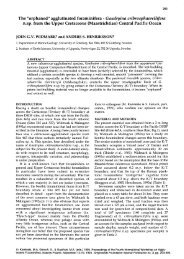Full Text | Download - Grzybowski Foundation - The ...
Full Text | Download - Grzybowski Foundation - The ...
Full Text | Download - Grzybowski Foundation - The ...
Create successful ePaper yourself
Turn your PDF publications into a flip-book with our unique Google optimized e-Paper software.
Alegret, Ortiz & Kaminski (eds.), 2012. Ninth International Workshop on Agglutinated Foraminifera, Abstract Volume<br />
A “Flysch-type” agglutinated foraminiferal assemblage from the Lower<br />
Carboniferous black shales of northern Saudi Arabia<br />
Michael A. KAMINSKI 1,2 , G. Wyn HUGHES 1,3 and Nigel HOOKER 3<br />
1 Earth Sciences Department, King Fahd University of Petroleum & Minerals, Dhahran, 31261, Saudi<br />
Arabia<br />
2 Department of Earth Sciences, University College London, Gower Street, London, WC1E 6BT,<br />
United Kingdom<br />
3 Geological Technical Services Division, Saudi Aramco, Box 10646, Dhahran, 31311, Saudi Arabia.<br />
e-mail: kaminski@kfupm.edu.sa<br />
A new assemblage of agglutinated foraminifera is described from Lower Carboniferous black<br />
shales of the Berwath Formation recovered in an exploration well drilled in northern Saudi<br />
Arabia. <strong>The</strong> recovered sediment consists of bioturbated black shale with stringers of thin<br />
siltstone and sandstone, and is the age equivalent of the Barnett Shale of Texas. <strong>The</strong> recovered<br />
assemblage comprises of exclusively agglutinated foraminifera characterized by diverse<br />
morphogroups, including free-living tubular forms that can be abundant. In this respect, the<br />
assemblage can be compared with the “flysch-type” assemblages described from the<br />
Cretaceous and Paleogene of the North Atlantic and western Tethys. <strong>The</strong> assemblage from<br />
Saudi Arabia displays higher diversity than previously described “Kinderhookian”<br />
agglutinated assemblages from the Lower Carboniferous shales and limestones in North<br />
America.<br />
<strong>The</strong> key feature that distinguishes the Saudi Arabian, Berwath Formation assemblage<br />
from the “Kinderhookian” and “Osagian” agglutinated assemblage described from North<br />
America (Conkin, 1961) is the presence of diverse free-living lituolids and trochamminids and<br />
the rarity of forms that grow attached to a hard substrate such as Tolypammina. Previously<br />
reported species of Ammobaculites from the North American assemblages contain typical<br />
Ammobaculites species that are round in cross-section such as A. pyriformis Gutschick &<br />
Treckman, A. gutschicki Conkin, or A. beveridgei Conkin & Conkin. In the present material,<br />
some species belonging to the genus Ammobaculites or Sculptobaculites are strongly<br />
compressed, to the point of closely resembling the Late Cretaceous to Cenozoic genus<br />
Glaphryammina. This is the first report of diverse compressed lituolids from the Lower<br />
Carboniferous. Even more striking is the presence of trochamminids with petaloid, digitate,<br />
and radially elongated chambers that even possess structures akin to primitive tubulospines.<br />
<strong>The</strong> obvious isomorphism between the Lower Carboniferous trochamminids and some Lower<br />
Cretaceous planktonic foraminiferal genera such as Clavihedbergella and Leupoldina is a<br />
topic of interest from an evolutionary point of view. Several species will be described as new,<br />
and others are left for now in open nomenclature. <strong>The</strong> finding of new Lower Carboniferous<br />
lituolids and trochamminids with distinctive “advanced” morphologies has implications for<br />
any hypothesis regarding the evolution and functional morphology of benthic foraminifera in<br />
dysoxic environments.<br />
Reference:<br />
Conkin, J.E. 1961. Mississippian smaller foraminifera of Kentucky, southern Indiana, northern<br />
Tennessee, and southcentral Ohio. Bulletins of American Paleontology, 43 (196), 368 pp.<br />
47



